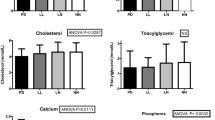Abstract
Trypsin-like activity is released after stimulation of the exocrine pancreas. We investigated under basal conditions and after stimulation by a meal whether patients suffering from pancreatic disorders differ with respect to plasma trypsin-like activity (PTLA).
In 45 subjects (healthy volunteers: n = 18, mild/moderate alcoholic chronic pancreatitis: n = 16, nonjaundice pancreatic cancer n = 7, and calcifying chronic pancreatitis: n = 4), basal and postprandial levels of PTLA were measured over a period of 2 hours.
Basal plasma levels were similar in the first 3 groups. After stimulation, healthy volunteers and patients with pancreatic cancer showed significant decreases in trypsin-like activity; however, plasma levels did not decrease in patients with mild/moderate chronic pancreatitis (P < .001).
Healthy individuals demonstrate a consistent decrease in postprandial trypsin-like plasma activity. This response is not altered in patients with pancreatic cancer, and it is not seen in patients with mild/moderate alcoholic chronic pancreatitis.
Similar content being viewed by others
References
Ohlsson K, Addeland A: Released of proteolytic enzymes in bile-induced pancreatitis in dogs. Gastroenterology 69:668–675, 1975
Ohlsson K: Acute pancreatitis. Biochemical, pathofisiological and therapeutic aspects. Acta Gastroenterolog Belg 51:3–12, 1988
Vercaigne D, Morcamp C, Martín JP, Joly JP, Hillemand B, Raoult JP: “Tryptic-like” activity in sera of patients with pancreatitis. Clin Chim Acta 106:269–277, 1980
Jacquot-Armand Y, Krebs G: The complex formed between trypsin and alpha(2)-macroglobulin retains the whole hydrolytic activity for benzoylarginine-p-nitroanilide. FEBS Lett 4:21–24, 1969
Hartwing W, Werner J, Jimenez RE, et al.: Trypsin and activation of circulating trypsinogen contribute to pancreatitis-associated injury. Am J Physiol 277:G1008–G1016, 1999
Layer P, Yamamoto H, Kalthoff L, Clain JE, Bakken LJ, Di Magno EP: The different courses of early and late-onset idiopathic and alcoholic chronic pancreatitis. Gastroenterology 107:1481–1487, 1994
Truninger K, Ammann RW, Blum HE, Witt H: Genetic aspects of chronic pancreatitis: Insights into aetiopathogenesis and clinical implications [review]. Swiss Med Wkly 6:565–574, 2001
Goldberg DM: Proteases in the evaluation of pancreatic function and pancreatic disease. Clin Chim Acta 291:201–221, 2000
Klöppel G, Maillet B: Pathology of acute and chronic pancreatitis [review]. Pancreas 8:659–670, 1993
Glasbrenner B, Kahl S, Malfertheiner P: Modern diagnostics of chronic pancreatitis. Eur J Gastroenterol Hepatol 14:935–941, 2002
Terry TR, Hermon-Taylor J, Grant DAW: The generation of lysolecithin by enterokinase in trypsinogen prophospholipase A2 lecithin mixtures, and its relevance to the pathogenesis of acute necrotising pancreatitis. Clinica Chimica Acta 150:151–163, 1985
Carter DC: Cancer of the pancreas. Gut 31:494–496, 1990
Dominguez-Munoz JE, Malfertheiner P: Optimized serum pancreolauryl test for differentiating patients with and without chronic pancreatitis. Clin Chem 44:869–875, 1998
Hedstrom J, Korvuo A, Kenkimaki P, et al.: Urinary trypsinogen-2 test-strip for acute pancreatitis. Lancet 347:729–731, 1996
Erlanger BF, Kokowsky N, Cohen W: The preparation and properties of two new chromogenic substrates of trypsin. Arch Biochem Biophys 95:271–278, 1961
Gabert VM, Jensen MS: A comparison of two methods to measure amylase, lipase, trypsin, and chymotrypsin activity and the effect of freezing and thawing on enzyme activities in pancreatic juice. Pancreas 5:183–190, 1997
Norhona N, Dreiling DA, Bordalo O: Sequential changes from minimal pancreatic inflammation to advanced alcoholic pancreatitis. Gastroenterologie 21:666–673, 1983
Koshikawa N, Hasegawa S, Nagashima Y, et al.: Expression of trypsin by epithelial cells of various tissues, leukocytes, and neurons in human and mouse. Am J Pathol 153:937–944, 1998
Werle E, Trautschold I: Physiology, pharmacology and pathology of exocrine pancreas enzymes with special reference to proteolytic enzymes [review]. Anglo Ger Med Rev 3:212–216, 1966
Domschke S, Heptner G, Kolb S, Sailer D, Schneider MU, Domschke W: Decrease in plasma amino acid level after secretin and pancreozymin as an indicator of exocrine pancreatic function. Gastroenterology 90:1031–1038, 1986
Maringhini A, Nelson DK, Jones JD, Dimagno EP: Is the plasma amino acid consumption test an accurate test of exocrine pancreatic insufficiency? Gastroenterology 106:488–493, 1994
Author information
Authors and Affiliations
Corresponding author
Rights and permissions
About this article
Cite this article
HernÁndez, C.A., NicolÁs, J.C., BiochD et al. Determination of Plasma Trypsin-Like Activity in Healthy Subjects, Patients With Mild to Moderate Alcoholic Chronic Pancreatitis, and Patients With Nonjaundice Pancreatic Cancer. Dig Dis Sci 50, 2165–2169 (2005). https://doi.org/10.1007/s10620-005-3026-6
Received:
Accepted:
Issue Date:
DOI: https://doi.org/10.1007/s10620-005-3026-6




